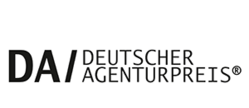
Award-Winning Trend Book: Accolades for Design and Content
Last year, the Handelskraft Trend Book was recognised with several awards: the German Marketing Award 2023 in the »Graphic Design (Brochure)« category and the DEUTSCHER AGENTURPREIS (German Agency Award) in the »B2B Content Marketing« category.


5 Digital Trends Discussed in the Handelskraft Trend Book 2024
The pace at which disruptions are changing the economy and society continues to increase. The associated digital trends provide companies with new opportunities to keep pace with this rapid transformation and boost their success. The Handelskraft Trend Book 2024 »Digital Metamorphosis« helps you understand business trends and leverage them to drive innovation forward.
Trend #1: AI Expertise Meets New Work
The use of artificial intelligence (AI) can lower process costs by up to
and increase conversion rates by up to
on top.
Building up AI expertise and benefitting twice
Companies that adopt modern working methods to establish the mindset required to acquire new skills benefit in two ways. With empathetic leadership, an open feedback culture and adapted job roles, they can increase employee satisfaction and the willingness to embrace the opportunities offered by new disruptive technology.
To accompany the shift in skills responsibly, companies should:
- analyse what skills are needed.
- specify job roles in the context of AI.
- create an AI expertise profile for each job role.
- identify training measures.

Trend #2: Measurable Business Goals
Companies that do not know where they stand cannot decide on their future direction.
Those who want to harness disruptive technology for their business growth first need a detailed concept for its implementation. Methods such as the use of objectives and key results (OKRs) help define a shared vision and make the progress towards achieving goals transparent. As part of this method, it makes sense to redefine goals for each trimester. This allows companies to respond to new requirements more flexibly and encourages employees to make their own contribution to the shared vision.
Tips for a successful start to using OKRs:
- Objectives must be formulated as specifically and precisely as possible and are ideally a source of inspiration.
- Key results should be as realistic, time-bound and measurable as possible.
- OKRs must be reviewed regularly and adjusted if necessary.
of companies are convinced that OKRs have a positive impact on their organisation.

Trend #3: Secure Agile Development
Software testing accounts for around
of the total development effort, making it a key starting point for improvements.
Testing at an early stage ensures resilience.
Agile coding methods such as the DevOps approach make it possible for companies to respond to changing customer requirements as quickly as possible and benefit from technological innovations. However, the need to create code at an ever-increasing pace makes the whole process more prone to errors.
The more advanced DevSecOps approach integrates security measures from the end of the development cycle into all phases, thereby intensifying collaboration between development (Dev), security (Sec) and operational (Ops) teams.
Closely linking development, security and operational processes:
- helps detect security vulnerabilities early on.
- makes it easier to comply with security standards.
- lowers development costs.
- shortens time to market.
- improves code quality.

Trend #4: Personalisation
Seamless, consistent and personalised target group approach
The more companies know about the target audience for their products and services, the better they can respond to changing expectations and set themselves apart from the competition. With the help of analytics tools, companies can better understand their customers' online behaviour and implement tailored measures such as personalised landing pages, banners and product recommendations. Only brands that communicate seamlessly and consistently with their customers across all relevant channels will be remembered positively.
Companies that address their target audience individually benefit from:
- a 70% increase in brand loyalty.
- doubled conversion rates.
- up to 40% larger orders.
of consumers expect personalised content.
are frustrated when it is missing.

Trend #5: Technology Meets User Experience
over a three-year period.
Combining digital disciplines and succeeding in e-business
E-commerce is far more than a functioning online shop. The increasing frequency of disruptions offers companies new opportunities to optimise digital experiences. However, this also makes it more challenging to effectively connect different solutions using a modular architecture. A dedicated digital experience platform (DXP) makes it possible to bring together existing tools and solutions and tailor all digital touchpoints contextually and according to individual needs.
A DXP offers companies the following benefits:
- Efficient data analytics
- Improved customer experience
- Higher conversion rates
- Enhanced brand image
Do you want to learn more? I'm looking forward to hearing from you!



